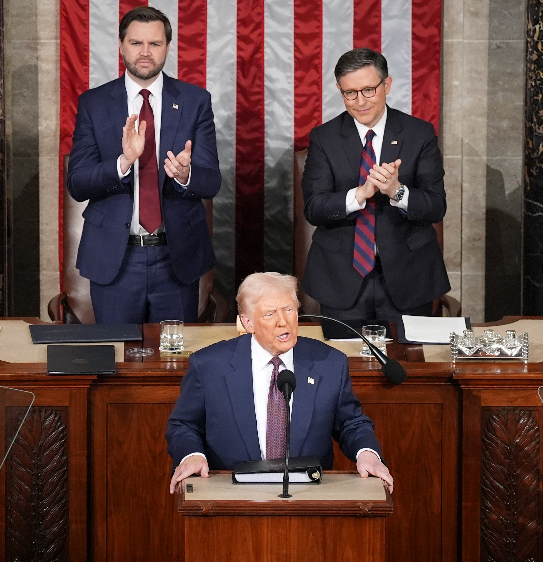
- Trump’s renewed commitment to economic nationalism was the main theme of his address.
- European allies are on edge due to his persistent mistrust of NATO, which is shown by his silence on future promises, especially because Ukraine is still in a vulnerable position against Russian attack.
- Trump’s speech articulated a vision of American dominance based on military might and economic independence, but it included few recommendations for coalition building or diplomatic engagement.
- Opponents fear a return to isolationism that might leave the United States strategically lost in a multipolar world, while proponents see a daring reaffirmation of American dominance.
Following his return to the White House, President Donald J. Trump presented his first speech to a joint session of Congress on March 4, 2025. His speech was a strategic statement rather than a conventional policy blueprint, declaring his administration’s resolve to remake the United States in a fractured world order. The economic nationalism, energy dominance, and focus on American might that characterised Trump’s rhetoric six weeks into his second term signalled both continuity with his previous government and a reorientation to accommodate new geopolitical circumstances. Beneath the bombast and wide-ranging promises, however, was a vision that may exacerbate relations with both friends and enemies.
The Shifting Global Context
Trump took office again at a time when the globe has changed dramatically since his first term. Although heated, the international system he found in 2017 was fundamentally solid. The 2025 world, however, is one of prolonged conflict, a dissolving Western alliance, and increased big-power competition. China’s geopolitical assertiveness is greater, the war in Ukraine remains unresolved, and core U.S. allies worried about Washington’s changed behaviour have sought alternative security and economic relationships. To this end, Trump’s speech was a deliberate action intended to redefine America’s role in the world, rather than a reiteration of his “America First” ideology.
Economic Nationalism and the China Challenge
Trump’s renewed commitment to economic nationalism was the main theme of his address. His rhetoric was primarily directed at China, which has solidified its economic leadership through the Belt and Road Initiative (BRI) and technological advancements in artificial intelligence and renewable energy. Trump also believes that it is unfair that American companies cannot have access to Developing Countries. He vowed to bring American industry back home and reduce reliance on foreign supply chains. Trump’s hard stance on domestic production and tariffs can be popular at home with his base, but it has downsides in foreign diplomacy. Such a stance might be interpreted as threatening free markets instead of addressing U.S.-China competitiveness by significant allies such as the European Union and Japan, whose economies are deeply entwined in global trade. Additionally, the leadership of the United States in international governance is also derailed by his depiction of renewables as merely an easy “supplement” to fossil fuels, which makes it at odds with global climate pacts.
Security Posture: Strength or Strategic Ambiguity?
Trump’s national security language was powerful as usual, but somewhat unclear in terms of strategy. Beyond general statements of American strength, his speech provided little detail on how his administration plans to address these issues, even while he reiterated a harsh position against both China and Russia. European allies are on edge due to his persistent mistrust of NATO, which is shown by his silence on future promises, especially because Ukraine is still in a vulnerable position against Russian attack. Trump runs the danger of giving Moscow more confidence by failing to provide a cogent deterrent policy, which would heighten worries that the United States may back out of its security obligations.
Likewise, although being presented as a local need, his emphasis on border security has important global ramifications. Economic instability, poor governance, and climate change are the main drivers of migration problems in Latin America, but Trump’s speech offered little sign of a more comprehensive hemisphere-wide approach to addressing these underlying issues. His limited strategy highlights a larger flaw in his foreign policy: a propensity to see world issues through a short-term, isolationist prism rather than a comprehensive strategic framework.
The Middle East Equation
Even while Trump shied away from confronting the most urgent problems facing the Middle East directly, his more comprehensive military and economic policies will surely influence the future of the area. His focus on the supremacy of fossil fuels suggests a continuing alignment with Saudi Arabia, but his lack of response to Iran’s nuclear aspirations and proxy wars begs the issue of how the administration would handle the area. The lack of a defined plan indicates either a conscious effort to preserve strategic adaptability or a lack of readiness to deal with one of the most unstable areas in the globe. Any perceived U.S. retreat might boost Tehran and its regional proxies, undermining an already precarious balance in the face of current tensions in the Persian Gulf.
America’s Fractured Global Image
Beyond the details of his policies, Trump’s address captured the larger issue of rebuilding America’s reputation abroad. His appeal for national unity ran counter to his often contentious statements, reflecting the larger battle the United States had to preserve its reputation as a world leader. The wider concerns regarding democratic erosion that have beset European and international partners were not touched on by his brief reference to the January 6 Capitol riots, framing it as a moment from which “we’ve all learned lessons.” Trump’s inability to fully confront these issues may further erode trust in Washington’s leadership among nations that view the United States as a bastion of democratic solidity.
The Tightrope of American Primacy
Trump’s speech articulated a vision of American dominance based on military might and economic independence, but it included few recommendations for coalition building or diplomatic engagement. His strategy depends on whether economic nationalism and the reality of a globalised world can coexist. Opponents fear a return to isolationism that might leave the United States strategically lost in a multipolar world, while proponents see a daring reaffirmation of American dominance. History has shown that in a world where problems ranging from geopolitical conflicts to climate change need collaborative solutions, unilateralism can only go so far. The stakes have never been greater, regardless of whether Trump’s policy works or further shatters the international system.
Shashank is a Master’s student in Diplomacy, Law, and Business at O.P. Jindal Global University. He is also a researcher and coordinator at the Center for Global South and the Center for Southeast Asian Studies. His research interests include Southeast Asia, Chinese foreign policy, India’s Act East Policy, and global security dynamics. Views expressed are the author’s own.
